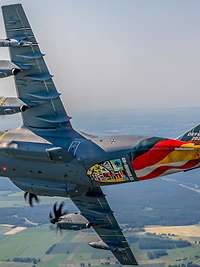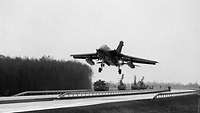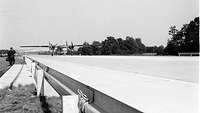
Air Defender 23
Multinational air operation exercise in Europe


During the Cold War, the Federal Republic of Germany, as a NATONorth Atlantic Treaty Organization member, played an important strategic role in the conflict between the two superpowers. In the event of a conflict, numerous NATONorth Atlantic Treaty Organization forces would have deployed to West Germany, including flying units from overseas. And these forces needed space.

Landing exercise involving German Air Force Tornado aircraft on the autobahn near the towns of Diepholz and Ahlhorn during the Operation Highway 84 exercise.
Bundeswehr/Mathias ZinsSince there were doubts that the existing airfields and air bases would be sufficient to provide the infrastructure required, autobahn emergency landing sites were established as an alternate option. In March 1984, NATONorth Atlantic Treaty Organization air forces trained the use and operation of such a site on autobahn A 29 near Ahlhorn.
Operation Highway 84 — probably the most unusual multinational air force exercise on German soil — was considered to be a test for the case of emergency. Assuming that the enemy would have destroyed the home air bases of friendly jet aircraft while they were still employed elsewhere, the pilots were to be given a chance to return anyway. The aircraft could have landed on the autobahns, been supplied with fuel, and accomplished new tasks. To this end, the exercise was also used to train re-arming of aircraft. The intention was to spread out the air forces in order to offer the enemy as few targets as possible. The highest density of autobahn emergency landing sites was found in Northern Germany. Six emergency landing sites were located along autobahn A 1 alone.
During this military exercise, 416 full stop landings, 1,475 touch-and-go approaches, 517 radar approaches and 47 TACANTactical Air Navigation approaches (this means navigation by using radio beacons) were carried out. Furthermore, mobile airfield lighting was tested for the first time. Several autobahn sections were used in the exercise maneuvers and fully closed to traffic — in some cases for several days. Besides the German Air Force, the air forces of Great Britain, Belgium, the Netherlands, Denmark and Norway as well as the French Armée de l’Air — although not a NATONorth Atlantic Treaty Organization member back then — participated in the exercise. The following aircraft types were employed: F-15, F-16, Starfighter, Phantom, Tornado, Alphajet, Jaguar, Fairchild A-10A, NF-5, Mirage III, C-160 Transall, Hercules, Do-28, Bell UH-1D, and BO-105.

Even USUnited States transport aircraft landed on the autobahn emergency landing site during the exercise. They demonstrated the performance capability of both pilots and infrastructure.
Bundeswehr/Günter OedThe first ever autobahn emergency landing site in Germany was built near the town of Lahr in 1961. It was not until 1966 that the construction of further sites began, and a total of seven sites had been built by 1968. According to the force plan for the period from 1969 to 1978, up to 60 emergency landing sites were to be established throughout the country. Between 1972 and 1985, another 16 emergency landing sites were built, with the last ones being completed in 1988.
A typical autobahn emergency landing site was composed of a straight autobahn section of 1,500 to 3,500 meters in length and at least 23 meters (later even 30 meters) in width. The median strip was completely concreted, and the guard rail between the traffic lanes was not bolted but furnished with a quick fixture so that it could be dismantled in a very short time. The reflector posts were only inserted and not embedded in concrete. At each end of the runway, there was a parking space that was intended to serve as a parking area for six to ten aircraft. These areas had a shape deviating from standard parking spaces and additional taxiways to the runway, which were closed by means of guard rails in peacetime. In most cases, there were access roads so that these areas could also be reached from outside the runway via connecting roads.
Some of the emergency landing sites had additional infrastructure such as concrete areas for various types of equipment. Cable ducts and channels, junction boxes, and sometimes even masts for radar or radio antennas had been prepared. However, there were no fixed lighting, radar or communications facilities. There was only one telephone main connection terminal. Infrastructure was kept available in mobile form in the vicinity and would have been operational on site within 24 hours in an emergency.
Besides fully developed emergency landing sites, there were obviously a larger number of less well-developed auxiliary emergency landing sites, such as the one on autobahn A7 between the towns of Berkhof and Schwarmstedt. Even though there was a completely concreted median strip, the typical parking areas were missing.
Activating these emergency landing sites would also have taken 24 hours, from alerting to operational readiness. Besides removing the guard rails, it would also have included installing runway lighting, a mobile tower and radar and radio equipment, attaching provisional runway markings, providing supplies of kerosene and ammunition, laying a total of about 40 kilometers of cables, and much more.
Today, these remnants of the Cold War disappear one after the other. The median strips are newly planted and the parking spaces are demolished or overbuilt when construction work is carried out to repair or enlarge the autobahns. And yet, when you look around in such parking spaces, you will still find a lot of details that serve as evidence of the use planned back in those days.
On the territory of the former German Democratic Republic, there also was a similar infrastructure. Here, the installations were simply called “Autobahn-Abschnitt” (autobahn section) or “ABA” for short. Some of them were used and maintained by the National People's Army, others by the Soviet army. With regard to their structure, the installations were largely identical to their western counterparts; they only differed in details.
by Thomas Skiba
Multinational air operation exercise in Europe